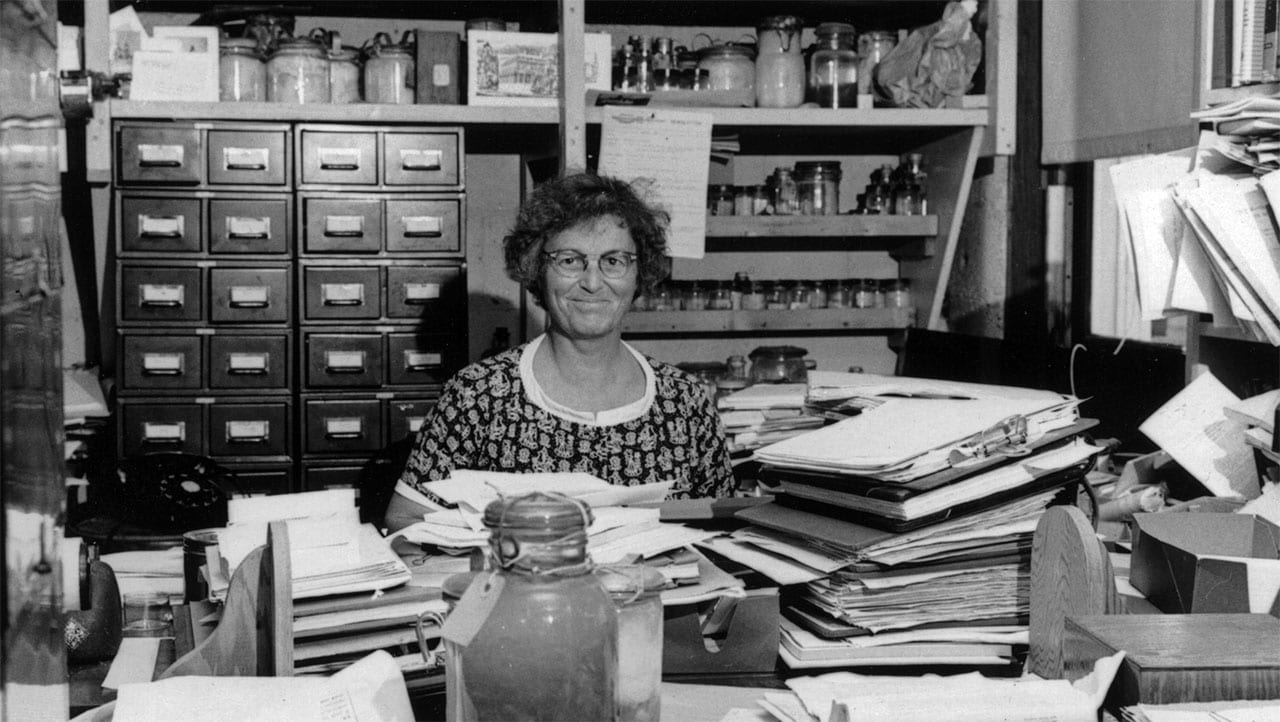Mary Sears Women Pioneers in Oceanography Award
Award Description
The Mary Sears Women Pioneers in Oceanography Award is one of the highest honors presented by the Woods Hole Oceanographic Institution (WHOI). The award recognizes long-term, life achievement and impact, with special consideration given to candidates who also have shown leadership through mentoring junior scientists, technicians, or students.
Mary Sears was the first recipient of the original Women Pioneers in Oceanography Award when it was initiated in 1994. Mary Sears passed away in September 1997 and in December 1999, through efforts of the Women’s Committee and in response to recommendations based on the Equity Climate Assessment Study of 1988, the Director and the Executive Committee of the Institution Board of Trustees renamed the Women Pioneers in Oceanography Award in honor of Mary Sears.
About Mary Sears
A marine biologist, the late Mary Sears received her doctoral degree in zoology from Radcliffe College in 1933 and went on to pursue a life long career in oceanography. She was one of the first staff members at WHOI and a guiding force in its development. She is widely credited with turning a new, obscure field into a prestigious international science, and was the founding and long-time editor of the journal Deep-Sea Research. She also helped to establish the journal Progress in Oceanography, and served as editor of a number of books considered milestones on documenting the history of marine science. As a principal organizer of the first International Oceanographic Congress at the United Nations, she forged many important links with marine scientists around the world. During World War II she organized and led the new Oceanographic Unit of the Navy Hydrographic Office, which provided the foundation for the current Naval Oceanographic Office.
As a graduate student she worked at Harvard University with Dr. Henry Bigelow, a founder and the first Director of WHOI. She began working summers at WHOI as a planktonologist in 1932, and was appointed as a planktonologist on a year-round basis in 1940. She also served as a research assistant at Harvard from 1933 to 1949, as a tutor at Radcliffe from 1934 to 1940, and as an instructor at Wellesley College from 1938 to 1943. In 1941 she served at Pisco Bay in Peru as Grant and Faculty Fellow for Wellesley College’s Committee on Inter-American Cultural and Artistic Relations. Mary Sears chaired and helped to establish the First International Congress on Oceanography, held at the United Nations in New York in 1959. She also served on the Joint Committee on Oceanography of the International Council of Scientific Unions from 1958 to 1960.
A Navy WAVE during World War II, she provided intelligence reports predicting the presence of areas of the ocean where submarines could help escape enemy detection. She was sent to Washington, DC during World War II to work in the Hydrographic Office, working with Roger Revelle and others until June 1946. Revelle, former Director of the Scripps Institution of Oceanography and founder of the University of California at San Diego, said in 1980 that “because the Federal Government has very little memory, it is generally forgotten that the first Oceanographer of the Navy in modern times was a short, rather shy and prim WAVE Lieutenant, j.g. ...They underestimated the powerful natural force that is Mary Sears. That tiny Oceanographic Unit soon became a Division, and finally the entire Hydrographic Office evolved into the Naval Oceanographic Office, headed by an admiral with the proud title of Oceanographer of the Navy.” Her intelligence reports, “Submarine Supplements to the Sailing Directions,” predicted the presence of thermoclines, or areas of rapid water temperature change, under which a submarines could hide to escape enemy detection by surface sonar. She established a small oceanographic unit in the Navy's Hydrographic Office and helped expand the role of applied oceanography within the Navy. In October 2000 the US Navy named a new naval research vessel, its sixth Pathfinder-class oceanographic survey ship, the USNS Mary Sears. This was the first time in it's 225 year history that the Navy named a research vessel for a woman.
Following mostly summer appointments at WHOI in the 1930s, she served on the scientific staff as a planktonologist from 1940 to 1963, eventually being named a Senior Scientist in the Biology Department, a position she held until her retirement in 1970. She was a Scientist Emeritus at WHOI at the time of her death in September 1997. Mary was also a long-time Member of the Corporation, serving as Clerk of the Corporation from 1947 to 1973 and as Deputy Clerk from 1973 to 1975. She was named an Honorary Trustee and Honorary Member in 1976 On the occasion of her 80th birthday in 1985, Deep-Sea Research dedicated an issue to Mary Sears, noting that she “has probably played a greater role in the advancement of oceanographic studies than any other woman.” As a member of nine scientific and honorary societies and long-time member of the governing board of WHOI, she was very influential in the development of WHOI, provided leadership across many oceanographic disciplines, and was an important mentor to generations of young scientists.

In this 1960 photo, Mary Sears is surrounded by papers and biological samples in her Bigelow Laboratory office. (Woods Hole Oceanographic Institution Archives)
